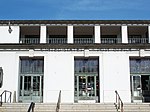Lobero Theatre
Buildings and structures in Santa Barbara, CaliforniaEvent venues established in 1873History of Santa Barbara County, CaliforniaLandmarks in CaliforniaSpanish Colonial Revival architecture in California ... and 2 more
Theatres in CaliforniaTourist attractions in Santa Barbara, California

The Lobero Theatre is an historic building in Santa Barbara, California. The theater was originally built as an opera house, in a refurbished adobe school building, by Italian immigrant José Lobero in 1873. Located downtown at the corner of Anacapa and Canon Perdido streets, the Lobero Theatre is registered as a California Historical Landmark.
Excerpt from the Wikipedia article Lobero Theatre (License: CC BY-SA 3.0, Authors, Images).Lobero Theatre
East Canon Perdido Street, Santa Barbara
Geographical coordinates (GPS) Address External links Nearby Places Show on map
Geographical coordinates (GPS)
| Latitude | Longitude |
|---|---|
| N 34.4216 ° | E -119.6999 ° |
Address
Lobero Theatre
East Canon Perdido Street 33
93101 Santa Barbara
California, United States
Open on Google Maps








